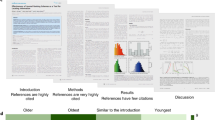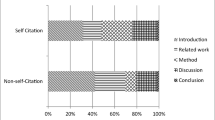Abstract
This article defines different perspectives for citations and introduces four concepts: Self-expected Citations, Received Citations, Expected Citations, and Deserved Citations. When comparing permutations of these four classes of perspectives, there are up to 145 kinds of equality/inequality relations. From these numerous relations, we analyze the difference between the Matthew Effect and the Matthew Phenomenon. We provide a precise definition and point out that many previous empirical research studies on the Matthew Effect based on citations belong primarily to the Matthew Phenomenon, and not the true meaning of the Matthew Effect. Due to the difficulty in determining the Deserved Citations, the Matthew Effect is in itself difficult to measure, although it is commonly believed to influence citation counts. Furthermore, from the theoretical facts, we outline four new effects/phenomena: the Self-confidence Effect/Phenomenon, the Narcissus Effect/Phenomenon, the Other-confidence Effect/Phenomenon, and the Flattery Effect/Phenomenon, and we discuss additional influencing factors.
Similar content being viewed by others
References
Bonitz, M. (2002). Ranking of nations and heightened competition in Matthew core journals: Two faces of the Matthew effect for countries. Library Trends, 50(3), 440–460.
Bonitz, M., Bruckner, E., & Scharnhorst, A. (1997). Characteristics and impact of the Matthew effect for countries. Scientometrics, 40, 407–422.
Bonitz, M., Bruckner, E., & Scharnhorst, A. (1999). The Matthew index—concentration patterns and Matthew core journals. Scientometrics, 44, 361–378.
Bornmann, L., & Daniel, H.-D. (2008). What do citation counts measure? A review of studies on citing behavior. Journal of Documentation, 64(1), 45–80.
Brooks, T. A. (1985). Private acts and public objects: An investigation of citer motivations. Journal of the American Society for Information Science, 36, 223–229.
Budd, J. M., Sievert, M. E., Schultz, T. R., & Scoville, C. (1999). Effects of article retraction on citation and practice in medicine. Bulletin of the Medical Library Association, 87(4), 437–443.
Cozzens, S. E. (1989). What do citations count? The rhetoric-first model. Scientometrics, 15, 437–447.
Egghe, L. (1993). Consequences of Lotka’s law in the case of fractional counting of authorship and of first author counts. Mathematical and Computer Modelling, 18(9), 63–77.
Egghe, L. (2008). Mathematical theory of the h- and g-index in case of fractional counting of authorship. Journal of the American Society for Information Science and Technology, 59(10), 1608–1616.
Garfield, E. (1962). Can citation indexing be automated? Essays of an Information Scientist, 1, 84–90.
Gaston, J. (1978). The reward system in British and American science. New York: Wiley.
Judge, T. A., Cable, D. M., Colbert, A. E., & Rynes, S. L. (2007). What causes a management article to be cited—article, author, or journal? Academy of Management Journal, 50(3), 491–506.
Lariviere, V., & Gingras, Y. (2010). The impact factor’s Matthew effect: A natural experiment in bibliometrics. Journal of the American Society for Information Science and Technology, 61(2), 424–427.
MacRoberts, M. H., & MacRoberts, B. R. (1989). Problems of citation analysis: A critical review. Journal of the American Society for Information Science, 40(5), 342–349.
Merton, R. K. (1968). The Matthew effect in science. Science, 159, 56–63.
Merton, R. K. (1988). The Matthew effect in science, II. ISIS, 79, 606–623.
Nicolaisen, J. (2007). Citation analysis. Annual Review of Information Science and Technology, 41, 609–641.
Petersen, A. M., Jung, W-S., Yang, J-S., & Stanley, H. E. (2011).Quantitative and empirical demonstration of the Matthew effect in a study of career longevity. Proceedings of the National Academy of Sciences of the United States of America, 108(1), 18–23.
Pislyakov, V., & Dyachenko, E. (2011). Citation expectations: are they realized? Study of the Matthew index for Russian papers published abroad. Scientometrics, 83(3), 739–749.
Rehn, C., Kronman, U., & Wadskog, D. (2007). Bibliometric indicators—definitions and usage at Karolinska Institutet. Stockholm, Sweden: Karolinska Institutet University Library.
Rossiter, M. W. (1993). The Matthew-Matilda effect in science. Social Studies in Science, 23, 325–341.
Rousseau, R. (1992). Breakdown of the robustness property of Lotka’s law: The case of adjusted counts for multi-authorship attribution. Journal of the American Society for Information Science, 43(10), 645–647.
Smith, L. C. (1981). Citation analysis. Library Trends, 30, 83–106.
The KNUDOP Search Group. (2008). Podunk effect. ISSI Newsletter, 4(2), 23.
van Dalen, H. P., & Henkens, K. (2001). What makes a scientific article influential? Scientometrics, 50(3), 455–482.
van Dalen, H. P., & Henkens, K. (2005). Signals in science—On the importance of signaling in gaining attention in science. Scientometrics, 64(2), 209–233.
van Raan, A. F. J. (2004). Sleeping beauties in science. Scientometrics, 59(3), 461–466.
White, M. D., & Wang, P. (1997). A qualitative study of citing behavior: Contributions, criteria, and metalevel documentation concerns. Library Quarterly, 67, 122–154.
White, H. D., Wellman, B., & Nazer, N. (2004). Does citation reflect social structure? Longitudinal evidence from the “Globenet” interdisciplinary research group. Journal of the American Society for Information Science and Technology, 55, 111–126.
Wouters, P. (1999). The Citation Culture (Ph.D. Thesis, University of Amsterdam, 1999).
Acknowledgments
This research was supported in part by National Natural Science Foundation of China (Project No. 70973117). We would also like to thank the reviewers for their helpful suggestions.
Author information
Authors and Affiliations
Corresponding authors
Rights and permissions
About this article
Cite this article
Wu, Q., Wolfram, D. The influence of effects and phenomena on citations: a comparative analysis of four citation perspectives. Scientometrics 89, 245–258 (2011). https://doi.org/10.1007/s11192-011-0456-0
Received:
Published:
Issue Date:
DOI: https://doi.org/10.1007/s11192-011-0456-0




